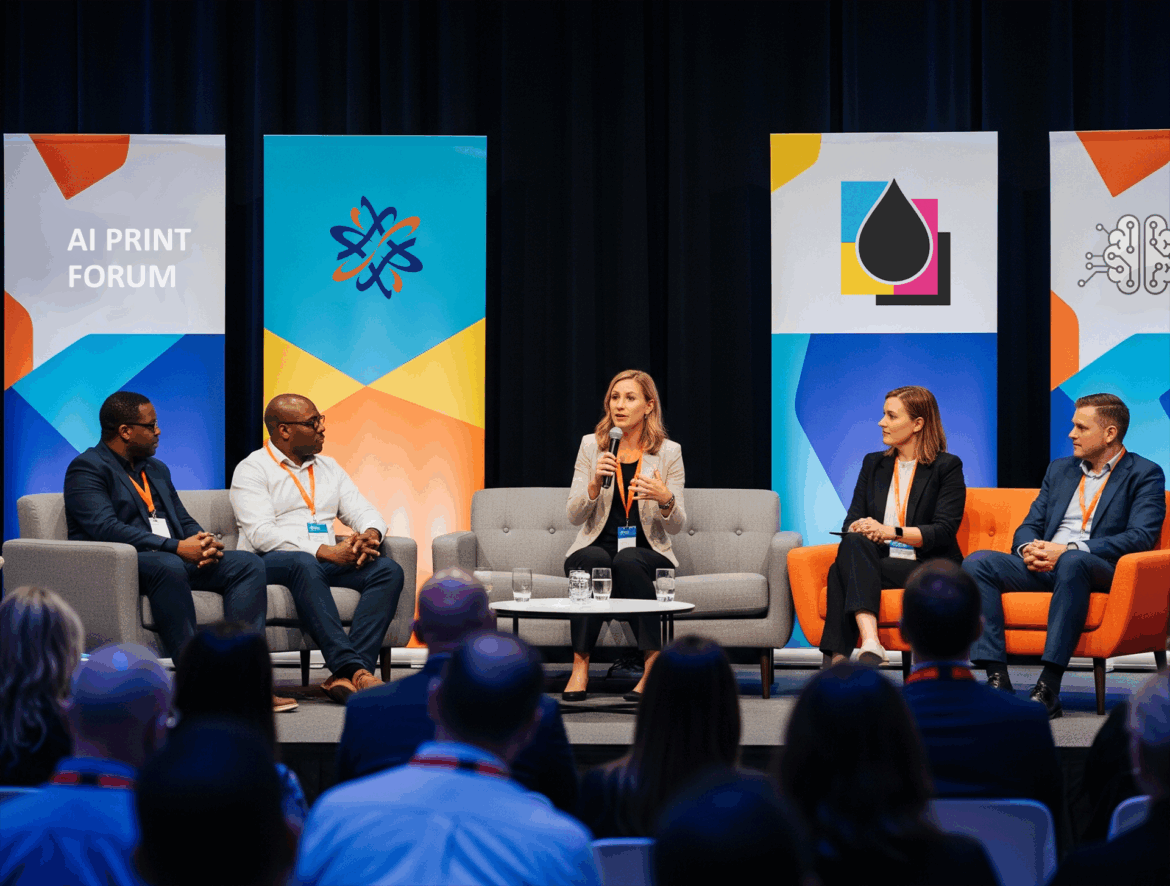The central question on every print leader’s mind is… “Will AI kill print jobs?” The short answer is… maybe, but only if we let it. A deeper look reveals AI as both a disruptor and an enabler.
Here’s an exploration from both sides of the debate.
What Makes AI a Threat to Print Jobs
1. Automation of Routine Tasks
AI excels at automating repetitive workflows, from automatic job scheduling and inventory management to defect detection and maintenance prediction. Printing presses now self‑optimize, adjust settings, and even reroute jobs without human intervention. These efficiencies threaten roles like press operators, prepress technicians, and shop floor staff, especially in high‑volume environments.
2. End‑to‑End AI Workflows
Tools for file‑checking, color profiling, layout automation, and quality control mean fewer manual checkpoints. AI‑driven prepress engines can now match colors, detect layout issues, and rerun files without human oversight. As these solutions mature, one can envision leaner print operations that rely on minimal staff.
3. Generative Design and Content Creation
AI tools are edging into design and marketing. Just as AI creates ad copy and images in media, it can also draft proofs, generate packaging motifs, or personalize banners without a designer’s input. Entry‑level design roles may be most exposed to this shift.
4. Cost Pressures on Small Publishers
As packaging and large‑format signage grow, small traditional commercial printers see shrinking margins. If they can’t afford advanced AI tech, they risk losing jobs and clients to bigger, automated competitors.
Why Print Jobs Are Not (Yet) Extinct
1. Human Creativity Still Matters
AI can assemble, optimize, and match, but printing is more than mechanized output. Creative roles, designers who interpret a brand, managers who handle client strategy, operators who solve on‑press issues, remain crucial. AI handles repetition; humans handle nuance. Experts from creative firms emphasize that AI augments rather than replaces authentic human creativity.
2. New Roles in AI‑Augmented Print
History shows that technological leaps also create jobs around them. Think of the printing press… scribes disappeared, but lay‑outs, typography, and publishing grew. In print today, that means demand for AI‑engine specialists, data analysts, color science experts, and automation engineers. Print becomes a smarter, tech‑driven ecosystem, not a human‑free zone.
3. Industry Shift Toward Packaging
While commercial print volumes shrink, packaging, especially digitally printed packaging, is thriving! AI is being applied here too, but small and medium printers that pivot to packaging can ride the growth wave. The jobs are not vaporizing, they are shifting into premium markets with strong demand.
4. Human‑AI Collaboration Is the Future
AI functions best under clear parameters. It doesn’t replace managers who set goals, troubleshoot, or coach staff. Fleet scheduling tools may automate, but operators still oversee quality and intervene when algorithms drift . The print floor becomes a hybrid ecosystem where AI handles scale and humans handle oversight.
Balancing Both Sides – The Real Outcomes
Displacement vs. Augmentation
Lower‑skill and repetitive roles, i.e. manual press adjustments, defect inspections, face real risk. The question is, can workers shift into new roles? If print businesses invest in reskilling, press CAD programming, color workflow auditing, sensor‑based maintenance, a displaced operator becomes a preventive maintenance specialist or QA analyst.
Scale Matters Alot
Larger organizations can afford AI‑powered presses, automated prepress, and predictive analytics. Smaller shops that adapt and invest strategically can pivot to packaging, artisanal short runs, or creative services. Those that resist risk being outpriced or overshadowed.
The Human Touch Still Pays Well
Local print brokers, event signage specialists, and high‑end design houses still rely on human judgement, responding to quick‑turn client requests, solving pressroom configuration issues, or delivering bespoke formats. AI lacks this adaptive, service‑oriented dexterity.
The Tipping Point for AI in Print Depends on Strategy
Speed of Adoption – Firms that integrate AI tools rapidly, press calibration bots, automated QA, color profiling, will see pressure on traditional roles first.
Reskilling Investment – Businesses that upskill staff into new roles, data, automation maintenance, front‑end user support, build resilience.
Sector Focus – Shops focused on packaging, personalization, and high‑value runs align better with AI‑driven quality demands. Commodity brochure printing faces shrinking margins.
Ethical Design – Firms emphasizing human‑AI partnership and fairness regulations (e.g. when automating hiring or supplier sourcing) will build trust and retain talent.
Takeaways on AI in the Print Industry
AI is a technological wave but not an existential tsunami, for print, its impact will be reshaping rather than erasing. Roles will split… simple and repetitive will fade, while strategic, creative, and tech‑centric roles will grow. The net effect? Print becomes smarter, more adaptable, and human‑empowered.
Industry leaders need to frame AI not as a job‑killer, but as a transformation engine. Invite disruption, but manage it: reskill teams, plan strategic pivots, and invest in human‑AI collaboration. Businesses that do will build competitive advantage. Those that don’t may indeed face obsolescence.
Will AI kill print jobs? In some traditional sense, yes, manual roles tied to repetitive tasks may disappear. But human ingenuity, creativity, and oversight remain irreplaceable. The printing industry is transitioning, not ending. The future belongs to businesses that pair AI’s power with human expertise.
In the end, AI won’t choose whether your press runs or staff thrive, you will. Use this wave to craft a smarter, more skilled, and resilient print workforce for tomorrow.
